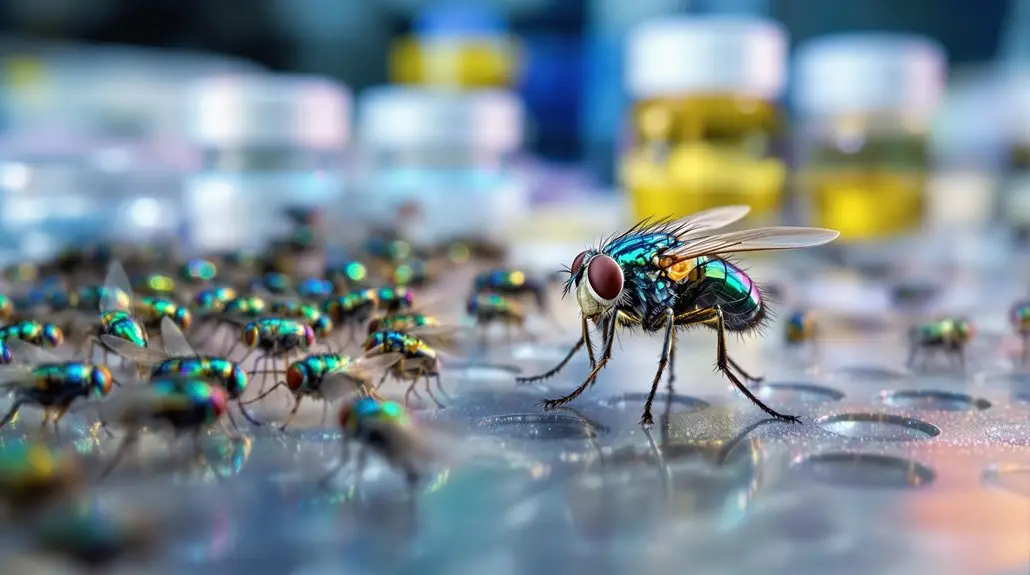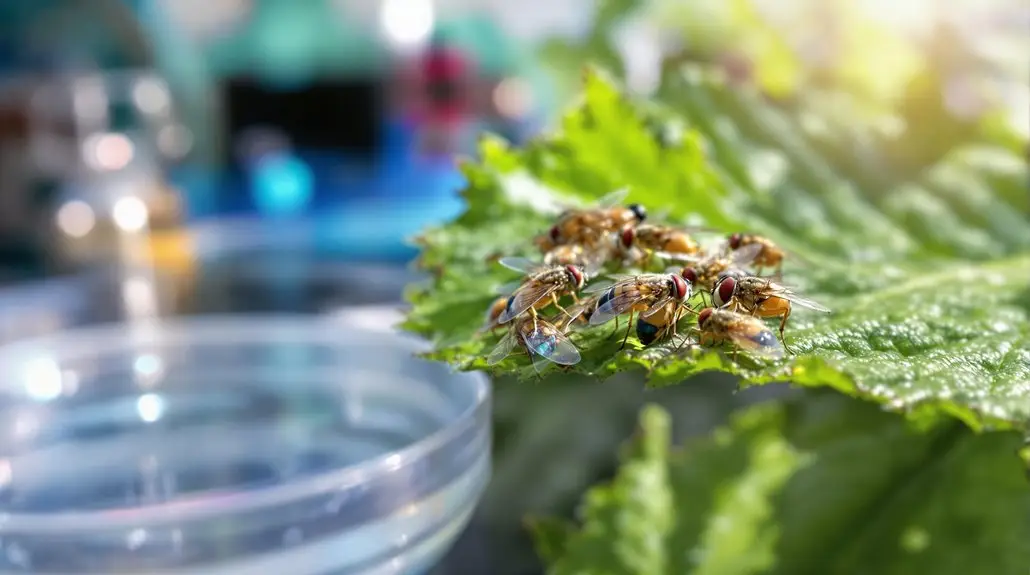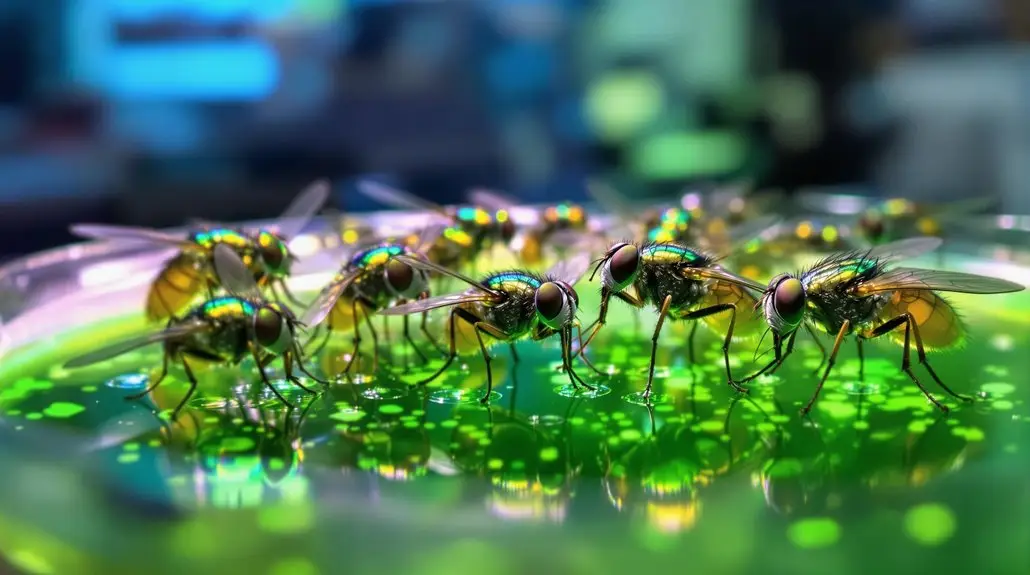
Researchers, including Jaqueline N. Torres and her colleagues, are examining the behaviorally resistant house flies, Musca domestica L., to imidacloprid, highlighting their mechanisms of neonicotinoid cross-resistance. They found that these flies can detoxify imidacloprid more efficiently due to overexpression of key enzymes like cytochrome P450 and specific behavioral adaptations, such as avoiding treated food sources. The study emphasizes the need for integrated pest management strategies to combat rapid resistance development, suggesting that insecticide rotations and non-chemical controls may be essential. You’ll uncover how these findings could impact future pest control approaches and management practices.

House fly resistance to imidacloprid poses a vital challenge in pest management. This resistance is primarily autosomal and displays incomplete dominant inheritance, meaning that the genetic traits responsible for resistance can be passed down from one generation to the next.
Key enzymes, including cytochrome P450, glutathione S-transferases (GSTs), and carboxylesterase (CarE), play critical roles in the metabolic detoxification of imidacloprid, enabling house flies to survive exposure to this insecticide. Importantly, the overexpression of cytochrome P450 genes, alongside a reduced expression of the nAChR subunit α2, considerably contributes to resistant phenotypes. Eco-friendly products can also be considered in pest management to minimize reliance on chemical insecticides.
Additionally, house flies exhibit specific resistance patterns; while they can detect and avoid imidacloprid, they don’t show behavioral cross-resistance to other neonicotinoids due to structural differences in these compounds. This is significant because house flies can transmit over 200 pathogens to humans and animals, heightening the importance of effective control strategies.
The physiological resistance that develops can be unstable, potentially disappearing if insecticide pressure is removed, whereas behavioral resistance tends to remain stable. This indicates that the genetic basis of imidacloprid resistance involves multiple factors, complicating management strategies.
With rapid resistance development observed—exemplified by a spinosad-selected strain showing a 279-fold resistance ratio after just 27 generations—understanding these mechanisms is essential.
Effective management strategies must include insecticide rotations and the integration of non-chemical control methods to mitigate resistance and maintain house fly population control.
Resistance to imidacloprid in house flies can manifest in various forms, each with distinct mechanisms. One of the most common types is metabolic resistance, where resistant insects detoxify or destroy the insecticide more quickly than susceptible individuals. These flies possess higher levels or more efficient forms of enzymes that break down imidacloprid into nontoxic compounds. This rapid detoxification capability is a key feature of metabolic resistance, which complicates pest management strategies as it can lead to the degradation of various insecticides. Effective pest control is achieved through safety-first approaches, highlighting the need for comprehensive strategies in managing resistant populations.
This enzymatic efficiency presents a significant challenge for control measures, as metabolic resistance can degrade various insecticides, complicating pest management strategies.
Another mechanism is altered target-site resistance, which involves genetic modifications at the specific site where the toxin binds. These modifications reduce the effectiveness of the insecticide, preventing it from interacting with its intended target. This type of resistance is specific to the insecticide’s mode of action and can lead to cross-resistance if multiple insecticides share similar binding sites.
Penetration resistance occurs when resistant insects absorb the toxin more slowly due to physical barriers in their outer cuticle. These barriers limit the absorption of chemicals into their bodies and often coexist with other resistance mechanisms, enhancing their overall effectiveness.
Finally, behavioral resistance involves the insects’ ability to detect and avoid the toxin. House flies can recognize imidacloprid and may refrain from feeding on treated food sources. This type of resistance has shown stability in populations, even when insecticide pressure is removed, making it a critical factor in understanding and managing resistance in house flies.

When analyzing cross-resistance in house flies, it’s essential to understand how different insecticides interact within the population. In recent experiments, researchers tested a variety of neonicotinoids, including acetamiprid, clothianidin, imidacloprid, nitenpyram, thiacloprid, and thiamethoxam, using three distinct chambers to evaluate fly behavior and mortality.
In these trials, 75 flies were distributed across chambers with either insecticide-treated sucrose, a choice between plain and treated sucrose, or plain sucrose alone. The results demonstrated that while flies exhibited high mortality rates (97-100%) in no-choice assays, indicating physiological susceptibility to all tested compounds, they specifically avoided imidacloprid in choice assays, revealing a lack of behavioral cross-resistance to the other neonicotinoids.
This behavioral resistance to imidacloprid appears stable within house fly populations, suggesting it could persist even when insecticide application changes. Physiological resistance often arises from overuse in agricultural settings, particularly in animal husbandry, which further complicates resistance management efforts. Structural differences between imidacloprid and other neonicotinoids may explain the flies’ ability to detect and avoid imidacloprid, allowing for continued effectiveness of alternative neonicotinoids in pest control strategies.
Additionally, the research indicates that rotating insecticides with different modes of action is essential for managing physiological resistance, although it may not entirely eliminate behavioral resistance. Consequently, understanding these dynamics is critical for effective pest management, as the stability of behavioral resistance could greatly impact the long-term success of imidacloprid as a control measure, emphasizing the need for ongoing monitoring and adaptation of control strategies in response to resistance patterns.
Feeding behavior in house flies reveals critical insights into their interaction with imidacloprid. Research shows that behaviorally resistant house flies exhibit a marked preference for untreated sucrose over sucrose treated with imidacloprid at concentrations greater than 25 µg/g. When given a choice, these flies actively avoid feeding on imidacloprid-infused food, indicating a specific detection mechanism for this insecticide.
While they do consume low concentrations (≤100 µg/g) of imidacloprid, their feeding behavior considerably decreases at higher concentrations, demonstrating a concentration-dependent response. This avoidance indicates an evolved behavioral response to the toxic effects of imidacloprid.
Specifically, resistant flies show reduced feeding at imidacloprid levels above 25 µg/g, particularly when untreated sucrose is available, highlighting their ability to detect and react to the presence of the insecticide. The threshold for reduced feeding varies, with considerable avoidance noted at higher concentrations, emphasizing the role of alternative food sources in their feeding decisions.
Moreover, this behavioral resistance stems not from a general aversion to neonicotinoids but from the flies’ ability to detect imidacloprid specifically, likely due to structural differences between imidacloprid and other neonicotinoids.
Importantly, the stability of this behavioral resistance in fly populations persists even when insecticide pressure is removed, suggesting that understanding these feeding behaviors is essential for developing more effective control strategies against imidacloprid-resistant house flies.

How can we effectively manage insecticide resistance in house flies? To combat resistance, one key strategy involves rotating insecticides with different active ingredient classes. By avoiding reliance on a single active ingredient or merely rotating within the same class—such as pyrethroids or organophosphates—you can prevent resistance development.
Instead, consider rotating baits that utilize various attractants, active ingredients, and modes of action. For instance, using QuikStrike® Fly Bait, Golden Malrin® Fly Bait, and Cyanarox™ Insecticidal Bait in succession can enhance control over fly populations while delaying resistance.
Additionally, continuous monitoring of fly population counts is essential. By evaluating the effectiveness of your current bait, you can determine when to switch to an alternative bait with a different active ingredient, ensuring ongoing efficacy. Incorporating diverse application methods, including residual treatment and larviciding, can further bolster your monitoring efforts.
Furthermore, utilizing insecticides from different Insect Resistance Action Committee (IRAC) mode of action classes reduces the risk of cross-resistance. This diversity is particularly important, as behavioral resistance specific to imidacloprid doesn’t extend to alternative neonicotinoids, allowing their use in control strategies.
Finally, understanding the stability and persistence of resistance types can guide your long-term plans; while physiological resistance may wane when insecticide pressure is lifted, behavioral resistance tends to remain stable, necessitating a proactive approach in managing resistance effectively.
Environmental factors that contribute to house fly resistance development include ideal temperature ranges, which favor larval growth and survival, and the availability of breeding sites, such as manure and garbage.
High moisture environments also enhance larval survival rates.
Additionally, frequent insecticide applications exert selection pressure, allowing resistant individuals to thrive and reproduce.
Consequently, effective waste management practices and rotating insecticides with varying modes of action can mitigate resistance development in house fly populations.
When considering how different insecticides affect house fly behavior, it’s essential to recognize that house flies can develop specific avoidance strategies toward certain chemicals, like imidacloprid.
They actively detect and avoid feeding on treated food, demonstrating behavioral resistance. However, this behavior doesn’t extend to other neonicotinoids, indicating a lack of cross-resistance.
Understanding these dynamics allows for strategic pest management, ensuring effective control through the appropriate selection of insecticides tailored to their behavior.
Yes, natural predators effectively control resistant house fly populations.
For instance, parasitoid wasps like _Spalangia endius_ lay eggs inside fly larvae, consuming them from within, while beetles such as _Carcinops pumilio_ prey on fly larvae.
Additionally, entomopathogenic fungi, particularly improved strains of _Beauveria bassiana_, infect and kill flies without harming beneficial insects.
You might think that house fly resistance is just a nuisance, but its economic impacts on agriculture are significant.
Annual losses from house flies and stable flies exceed $1 billion in the U.S., affecting livestock health and productivity. These pests reduce cattle weight gains by up to 20%, while also increasing veterinary costs due to disease transmission.
Consequently, managing fly populations through insecticides and integrated pest management adds further financial strain on farmers.
To effectively monitor resistance in fly populations, farmers should regularly collect samples from their fields, ensuring they maintain the flies’ natural state by avoiding stressors like heat or starvation.
Conducting bioassays, such as residual contact or feeding assays, allows you to assess insecticide susceptibility. By comparing mortality rates to a known susceptible population, you can determine resistance levels, which will help inform your management strategies and adjust insecticide use accordingly.
The Key to Sustainable Pest Control: Understanding Resistance****
In conclusion, the research on imidacloprid-resistant house flies reveals significant implications for pest management strategies. Understanding the mechanisms of resistance and the potential for neonicotinoid cross-resistance is vital for developing effective control measures. By examining feeding behavior and resistance patterns, researchers can better inform strategies that mitigate resistance development.
As the saying goes, “an ounce of prevention is worth a pound of cure”; proactive management can protect the effectiveness of insecticides against these resilient pests.
For those in South Florida facing challenges with pest resistance, we encourage you to partner with NaturePest Holistic Pest Control. Together, we can implement innovative and sustainable pest management solutions that not only tackle current infestations but also prevent future resistance issues. Take action today to safeguard your environment!